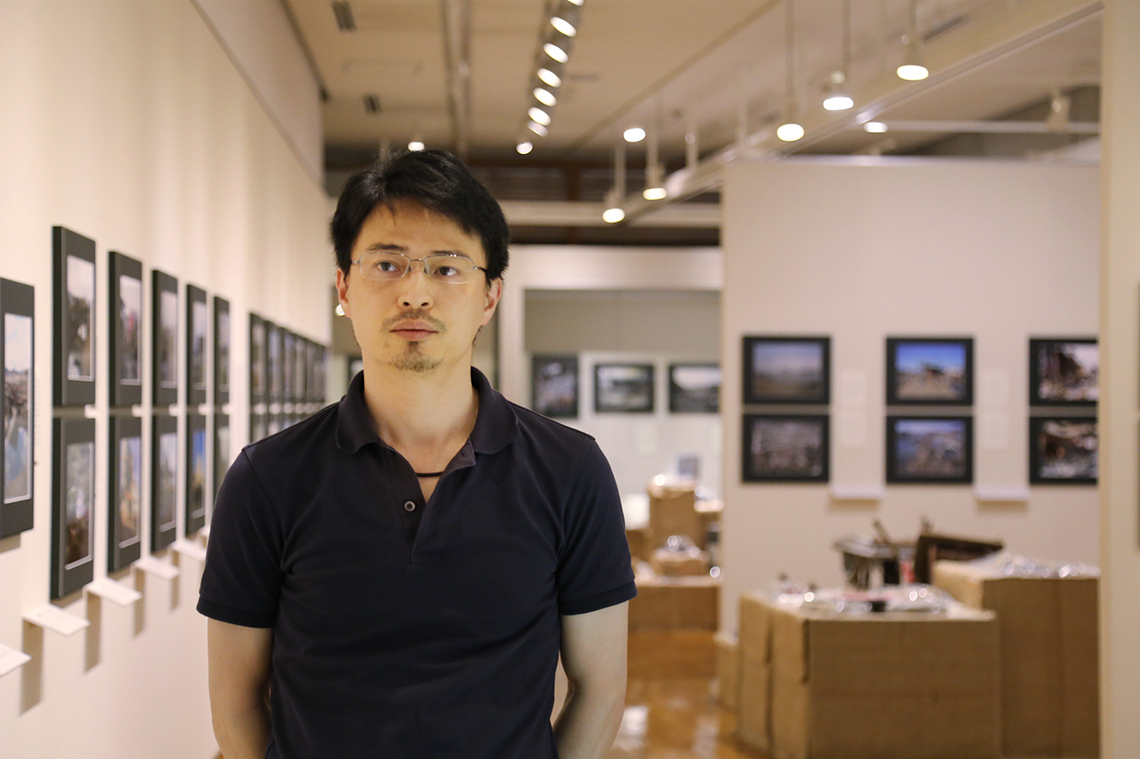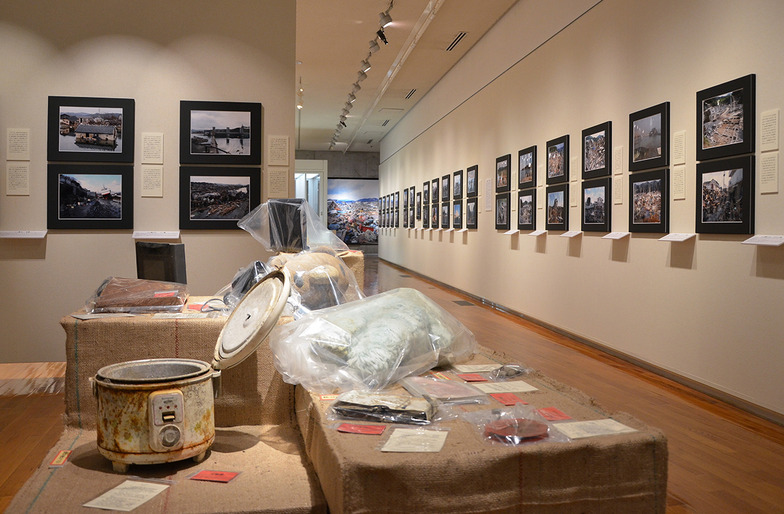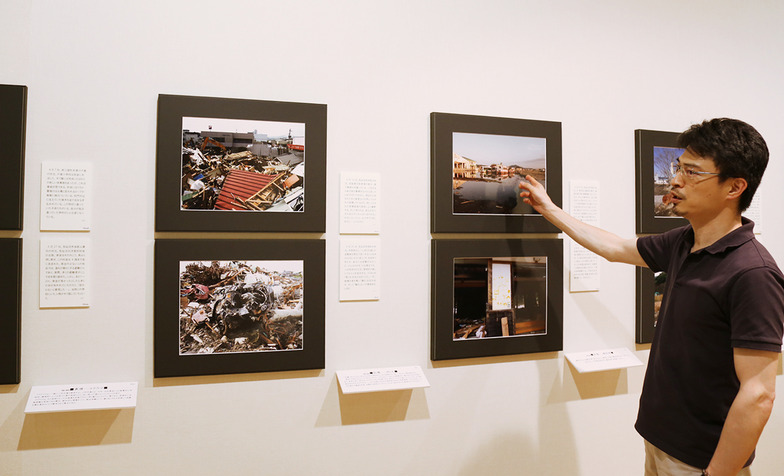Note: This website was automatically translated, so some terms or nuances may not be completely accurate.
Exhibiting records from the disaster-stricken areas To make use of them in the future

Hiroyasu Yamauchi
Curator, Rias Arc Museum of Art
September 11th this year marks five and a half years since the Great East Japan Earthquake. Since then, various initiatives have been developed for disaster mitigation and prevention. The Rias Ark Museum in Kesennuma City, Miyagi Prefecture, is attempting to make the records of the disaster-affected areas useful for the future through exhibition. We spoke with Hiroyasu Yamauchi, Curator, about the background, process, and his thoughts on this endeavor.
Tsunamis are indispensable to regional cultural studies
The Rias Ark Museum of Art functions more like a comprehensive museum. Even before the Great East Japan Earthquake, it preserved and permanently exhibited historical and ethnographic materials related to local life and culture, alongside art. Among its preserved materials were three volumes of the special supplement "Record of the Great Tsunami Disaster," published by the magazine Fuzoku Gahō to document the 1896 Meiji Sanriku Tsunami. Although the earthquake's shaking wasn't particularly strong, a tsunami over 10 meters high struck the Sanriku coast, claiming approximately 22,000 lives. We reproduced 70 illustrations drawn by artists, enlarged them onto panels, and held a special exhibition in 2006. At that time, the recurrence interval for the Miyagi Offshore Earthquake was roughly known. It was said that an earthquake would occur within 30 years, with a 99% probability of a tsunami following – meaning it could strike at any moment. So, we emphasized that this would inevitably happen in the near future. The Meiji-era records included detailed damage accounts using the exact same place names used today. This meant people could see exactly what scale of tsunami had struck the very place they now lived, and what had happened.
However, during the nearly one-and-a-half-month exhibition period, only about 1,200 people came to see it. Despite trying to convey the imminent danger of an actual future event, people showed little interest. I wondered if there was another way to get this information across. Based on all the data stored in my head, I wrote the novel 'Sand Castle' and published it in 2008.
The catalyst that brought these efforts to light was the Chilean earthquake tsunami in February 2010, roughly a year before the Great East Japan Earthquake. Coverage on TV programs and in newspapers sparked a small movement urging a reexamination of past tsunami damage. I was also invited by a local university to give a lecture at a public seminar. Since this is a region where major tsunamis strike on average once every 40 years, it's impossible for them not to have influenced the local culture. Therefore, when considering regional culture, tsunamis cannot be ignored. With this awareness, our museum had already begun tsunami research and investigation from a cultural perspective even before the disaster.

Risking their lives to document the disaster sites
March 11, 2011: The Great East Japan Earthquake struck. Our museum suffered severe damage, rendering it unusable as an evacuation center. It was temporarily repurposed as a relief supply storage facility. On the night of the 15th, after the supplies were moved elsewhere, we curators gathered and decided: even if the museum never reopened, even if we lost our jobs, we would document this. It was something only we could do. Why?
First, we had prior knowledge of tsunamis. And if anyone should conduct this survey and research, it would be us, the specialists. Furthermore, we knew the town before the disaster. At the time, photographers who came from outside often stood there momentarily stunned. They frequently said they didn't know what to photograph. But we knew exactly where the damaged areas were and what had been destroyed.
Then, on the 16th, we voluntarily took our cameras and entered the disaster sites. On the 23rd, we received a special assignment from the Mayor of Kesennuma and the local Board of Education to document the disaster damage and conduct surveys in Kesennuma City and Minamisanriku Town. Our goal was to record the current state for regional reconstruction. We continued this activity for about two years, until December 31, 2012. As a result, we gathered approximately 30,000 photographs, about 250 damaged artifacts, and a vast amount of other materials, including survey records. From this collection, we have carefully selected about 500 items to present in the permanent exhibition "Records of the Great East Japan Earthquake and the History of Tsunami Disasters."

Photo courtesy of Rias Ark Museum of Art
Photographer's commentary conveys the meaning behind the photos
"Unused records have no meaning" is my conviction, and I agonized over "how to convey what I want to convey." Take photos of disaster sites, for example. The information conveyed by these images is overwhelmingly greater than what humans can process. Viewed alone, they leave a uniform impression of "utter chaos." Therefore, every photo panel displays an accompanying caption written by the photographer themselves. These captions explain what the photographer sensed with their five senses, what they thought, and why they took the photo – helping viewers understand its meaning. One could even say these captions are more important than the photographs themselves.
Currently, our museum welcomes many visitors ranging from elementary school students to university students, including numerous people from overseas. Recently, we've seen an increase in visitors from areas where the Nankai Trough earthquake is anticipated.
However, our challenge is the near absence of group visits from local schools. Among children living in the same area who were not directly affected by the disaster, some have memories centered around celebrity visits and events. We want them to understand what happened in their own community, what the townspeople endured, and to apply this knowledge to future community building and their own futures.
This June, we were deeply honored to receive the 10th Nogami Hiroko Memorial Art Documentation Promotion Award from the Art Documentation Society for our exhibition. To make this exhibition accessible to people in other regions, we prepared a full set of loanable photo panels and exact replicas of disaster-affected items. We held traveling exhibitions at the Hiroshima Onomichi City Art Museum in 2014 and at the Meguro Museum of Art in Tokyo from February to March this year. We sincerely hope that many more people will see this exhibition and that it will contribute to disaster prevention and mitigation, material and psychological preparedness, and legal frameworks.

Was this article helpful?
Newsletter registration is here
We select and publish important news every day
For inquiries about this article
Author

Hiroyasu Yamauchi
Curator, Rias Arc Museum of Art
Born in Ishinomaki City, Miyagi Prefecture, in 1971. Curator at the Rias Ark Museum of Art since 1994 (currently Curator and Head of Curatorial Affairs at the museum; resides in Kesennuma City). Member of the Kesennuma City Great East Japan Earthquake Heritage Preservation Committee and the Kesennuma City Great East Japan Earthquake Ruins Preservation Committee. Rias Ark Museum of Art <a href="http://riasark.com/" target="_blank">riasark.com</a>